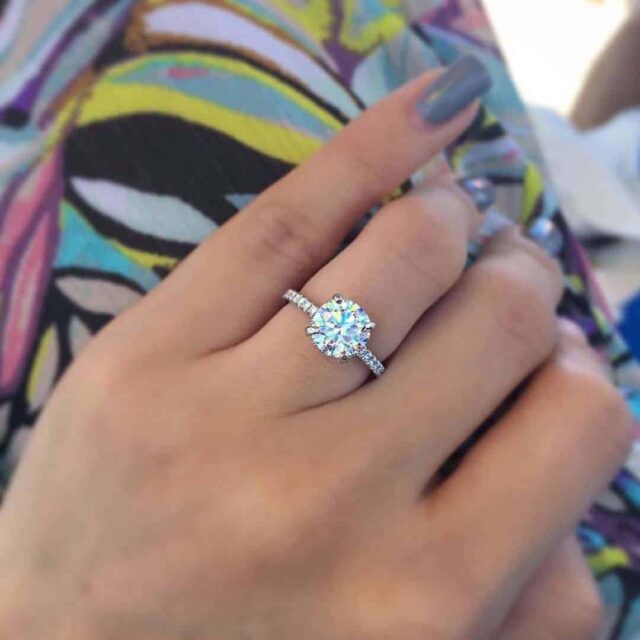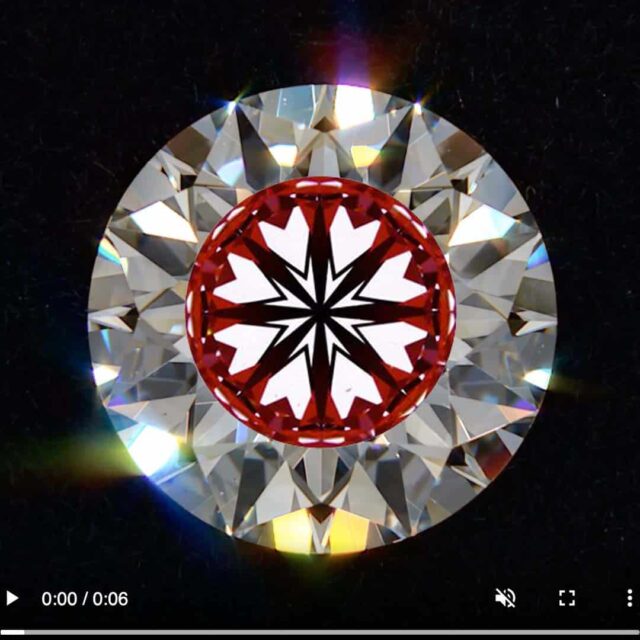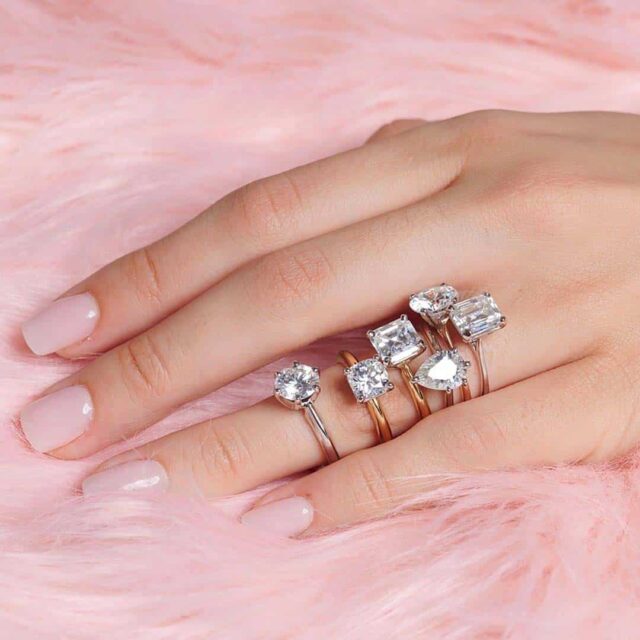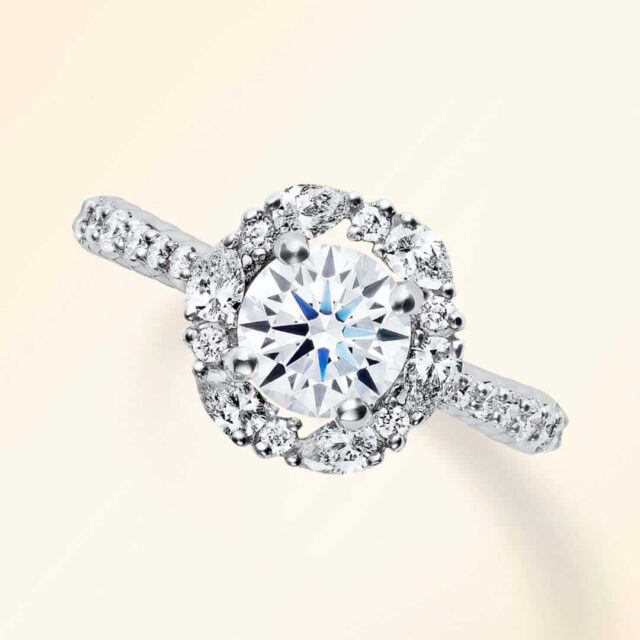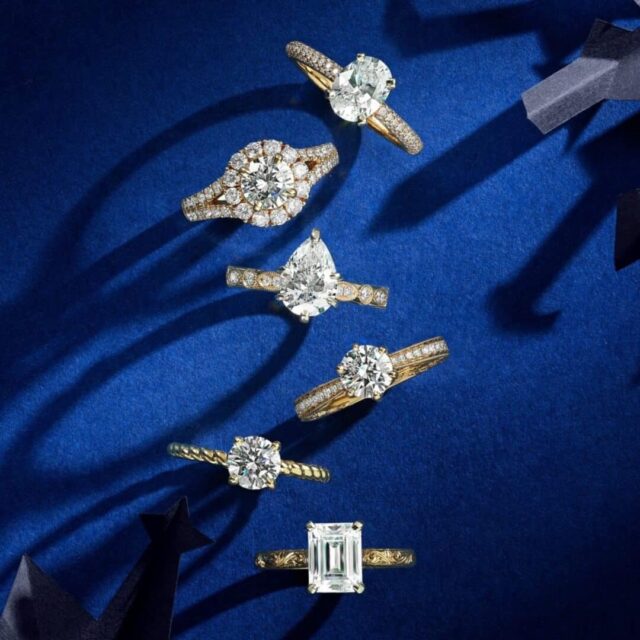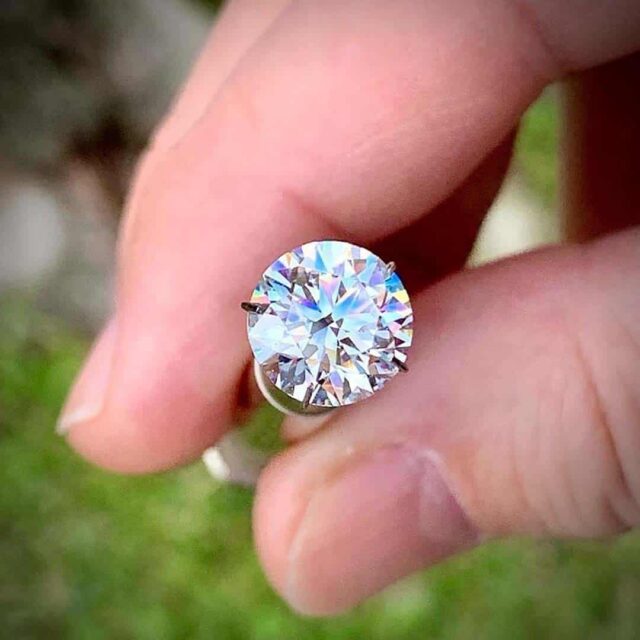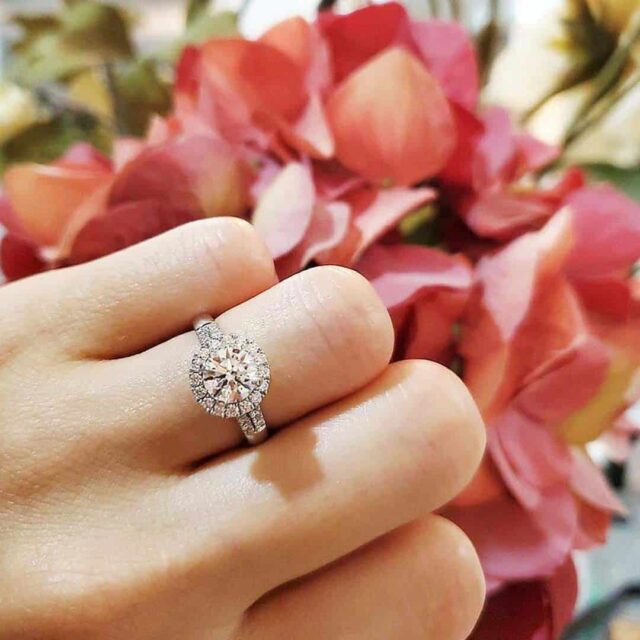How do COSTCO Diamonds stack up against Blue Nile? We received this inquiry from a client who wants to know the difference between COSTCO and Blue Nile Diamonds:
"I'm looking at COSTCO Diamonds and Blue Nile. I like 1-1.5 carats and think we have a budget of 8K. But, we might be able to go up a little more than that depending on what Costco offers."
"I want a good diamond and like the pave petite round setting. I think that is the name. I am new to researching diamonds. Is this price range possible? Here are a few COSTCO Diamonds that I'm thinking about right now." -- Tina G.
Follow along and see whether Costco or Blue Nile diamonds are the best.
Tips For Buying Blue Nile and Costco Diamonds:
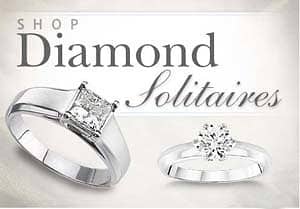
The COSTCO diamonds below are the ones that this client is considering. As with all of the diamonds that I review, we will consider them based on my selection criteria.
It's important to realize that there is only so much that you can tell about a diamond by the numbers. That is why I prefer evaluating loose and using reflector scopes to judge optical precision.
An ASET Scope reveals how well a diamond makes use of the available light in the room. It will also enable you to determine how evenly light reflects throughout the diamond and the degree of leakage.
In contrast, an Ideal Scope only helps to identify light leakage. Unfortunately, neither Blue Nile nor Costco Diamonds provides these images routinely. In that case, it can feel like you're trying to buy diamonds in the dark.
Verify Optical Precision Using Hearts and Arrows Scope:
In addition to ASET and Ideal Scope, we use a Hearts and Arrows Scope to verify optical precision. That is the consistency of facet shape, size, and alignment throughout the diamond. The combination of these factors will have a direct impact on the volume of light return and sparkle intensity.
Unfortunately, most box stores don't provide the reflector scope images necessary to judge light performance. Neither do most online retailers like Blue Nile. Consequently, I've never seen any H&A Scope images for Costco diamonds.
That makes it difficult to judge the degree of light leakage and their diamonds' light performance. On the other hand, diamond cutters like Brian Gavin provide those images for your peace of mind.
Costco Diamonds Review: GIA #5123030941
The characteristics of this diamond engagement from Costco are as follows:
Let's begin by looking up this diamond using GIA Report Check. That way, we'll have all the relevant details, such as proportions and clarity characteristics. According to the GIA, the details of report #5123030941 for this Costco diamond are as follows:
How to Evaluate Costco Diamonds:

If you're familiar with my selection criteria, then you know that this Costco diamond doesn't make the grade. In the first place, the crown angle of 32.5° is too shallow. Generally speaking, you want the crown angle to be between 34.3 to 35.0 degrees.
Comparatively, this diamond's crown angle is likely to produce a lot of brilliance (white sparkle). At the same time, it will likely be at the expense of dispersion (spectral bliss/fire).
In contrast, a crown angle between 34.3 and 35° will produce a virtual balance of sparkle factor. That is preferable because you'll see the full-spectrum of sparkle, whether from Blue Nile or Costco Diamonds.
Proportions of Costco Diamonds:
The Costco diamond above has a 59% table diameter. That is too large given the shallow crown angle and will negatively impact light performance.
For one thing, it can make the arrows pattern look thin and spindly. It's also likely to create a lot of obstruction under the table facet.
Under normal circumstances, the pavilion angle of 40.8° will produce a high volume of light return. However, each piece of the diamond works in conjunction with the other parts. Hence the joke about one plus one equals three.
I'm sure you can see why I can't recommend this Costco diamond. Given these points, it should be clear that the GIA Excellent cut grade parameters are too broad. Although this may be true, the specifications for other Costco diamonds might be better. Consequently, we could say the same thing about Blue Nile diamonds.
Blue Nile Diamond Review, GIA 2137840617:
How does the Costco diamond above compare with what I was able to find at Blue Nile? In like manner, the crown angle of this 1.13 carat, G-color, VVS-2 clarity, GIA Excellent cut diamond from Blue Nile is a bit shallow.
However, the crown angle of 34 degrees is preferable and should produce better sparkle. According to the GIA, this diamond has a total depth of 59.3% and a 58% table diameter.
The pavilion angle of 40.8 degrees should produce a high volume of light return. Simultaneously, the 34° crown angle creates a reasonably good balance of brilliance and dispersion.
Double Check the Crown Angle:
The 34° crown angle on the Blue Nile diamond above is likely to produce slightly more brilliance than dispersion. That means that this diamond will probably exhibit a little more white sparkle than fire.
The difference in sparkle between a crown angle of 34 - 34.3 degrees is slight by the same token. The odds are that most people are not likely to notice the difference without some coaching.
The proportions of this diamond are within the spectrum for the AGS Ideal-0 cut grade. On the contrary, the proportions of the Costco Diamonds above are not within the ideal range.
Besides, I don't know how the IGI came up with this Costco diamonds ring's value. However, I assume that it represents their estimate of full-blown retail and includes the ring's cost. Consequently, the Blue Nile diamond is selling for $11,301 and offers better performance.
If you're keeping score, it's currently Blue Nile: 1 / Costco: 0
Costco Diamonds Review - GIA #5126183164:
According to the GIA, this Costco diamond has a total depth of 60.0% and a 59% table diameter. The diamond also has a 33° crown angle offset by a 41-degree pavilion angle. The girdle edge is medium to slightly thick and faceted, and the culet size is none.
This diamond has an overall grade of GIA Excellent and proportions within the Ideal spectrum. Be that as it may, the crown angle of 33 degrees is much shallower than I prefer.
Despite that fact, some jewelers think that a shallow crown is a reasonable offset for a steep pavilion. I'm not one of those people because I know that this combination has drawbacks.
The pavilion depth of 43.5% is too steep to produce an exceptional light return. Consequently, it's the critical tipping point where light begins not to strike the pavilion facets optimally. This Costco diamond is likely to leak a lot of light as a result.
Blue Nile vs. Costco Diamonds Prices:
Unfortunately, Tina didn't provide me with the Prices for these Costco diamonds. For this reason, I don't know how they compare with Blue Nile diamond prices. Be that as it may, this 1.27 carat, G-color, VVS-2 clarity, GIA Excellent diamond from Blue Nile has better proportions.
This Blue Nile diamond has a total depth of 61% and a 57% table diameter. The pavilion angle of 41 degrees is still steeper than I prefer. However, the 43% pavilion depth will produce a better light return than the 43.5% on the Costco diamond.
At the same time, the crown angle of 34.5° should produce a virtual balance of brilliance and dispersion. With this in mind, this one should exhibit better light return and sparkle than the Costco diamonds above. The current price is $13,862.00 for this GIA Excellent round diamond from Blue Nile.
The score is now Blue Nile: 2 / Costco: 0
Costco Diamonds Review: GIA #2131719297
The proportions diagram for this GIA Excellent round diamond from Costco is to the left. As can be seen, the pavilion depth is 43.5% once again.
Remember, this is the critical tipping point where the volume of light return begins to drop. With this in mind, we want to avoid that 41°/43.5% pavilion angle/depth combination.
On the positive side, the 34.5° crown angle should produce a virtual balance of brilliance and dispersion. However, that doesn't matter because the 43.5% pavilion depth is a deal killer.
Avoid the 43.5% Pavilion Depth:
Buying a round diamond with a 43.5% pavilion depth is like purchasing a 100-watt lightbulb that only delivers 1000 lumens instead of the standard 1600.
Besides, the total depth of 62.1% has a hidden cost that most people don't consider. If the total depth measurement is too deep, it can negatively impact the diameter. In that case, you're paying a premium for carat weight in the form of total depth instead of visible surface area.
In other words, the visible outside diameter of your diamond shrinks as the total depth increases. That is why I recommend keeping the total depth between 59 - 61.8% for round Costco diamonds.
Blue Nile Diamond Review, GIA 5131940712:
At present, this 1.12 carat, H-color, VVS-2 clarity, GIA Excellent round from Blue Nile is the best comparison to the previous Costco diamonds.
To the left is the clarity photograph for this diamond from Blue Nile. This diamond has a total depth of 61.3% and a 57% table diameter.
The 40.6° pavilion angle should produce a high volume of light return. The 35° crown angle should simultaneously create a virtual balance of brilliance and dispersion.
The visible outside diameter of this diamond is more significant because of the shallower total depth. This diamond measures 6.68 - 6.72 mm, so it has an average outside diameter of 6.70 millimeters.
Accounting for Total Depth:
While the 1.13 carat from Costco measures 6.66 - 6.68 millimeters and has an average outside diameter of 6.67 millimeters. Consequently, the smaller Blue Nile diamond faces up larger.
For this reason, I prefer a total depth between 59-61.8% for round brilliant cut diamonds. For information on fancy shape diamonds, refer to this article on calculating proportions.
By the way, this Blue Nile diamond is currently selling for $8,654.00. That seems better than the price of Costco Diamonds.
The current score is Blue Nile: 3 / Costco: 0 (that means something in baseball).
Are Costco Diamonds Good Quality?
Under the circumstances, you might be thinking that Blue Nile diamonds are better than Costco diamonds. Although this may be true, it also might not be because this game is rigged.
In the first place, the Costco diamonds I'm reviewing are the ones that our client is considering. In that case, there is a good chance they won't meet my selection criteria.
On the other hand, the odds are high that my search will yield better results. After all, I'm a diamond buyer by profession with 35+ years of trade experience.
If you search Blue Nile, you'll see plenty of options with proportions similar to Costco diamonds. In that case, you'll find that most of their diamonds don't make it.
This Costco Diamonds vs. Blue Nile Review Seems Skewed:
To put it differently, when I search for diamonds, the goal is to cherry-pick the best options available. That means I'm not going to mention Blue Nile diamonds that aren't better than Costco diamonds. That's just common sense. LOL, I guess I cheated!
DOH! Nevertheless, it's essential to keep things in perspective. In the first place, these are the Costco diamonds that interest my client. To that end, I don't believe that it's my fault that they don't meet my standards.
Try to see the situation from my vantage point. The client chose these diamonds from Costco, not me. Likewise, the comparison between Blue Nile and Costco Diamonds is at the client's request.
With that in mind, it's in my client's best interest for me to provide her with better options. She can always use the insight herein to select other Costco diamonds that might perform better than these.
Brian Gavin vs. Blue Nile vs. Costco Diamonds:
If you're looking for the most spectacular looking diamond possible, here's a little advice. The first thing to remember is that diamond cut quality dictates light performance.
That means that the combination of proportions and optical precision will determine the light return and sparkle intensity. To put it differently, you're not going to get the best performance from a diamond with less than perfect make.
Although this may be true, the proportions of a diamond are only one piece of the puzzle. The degree of optical precision has more influence on the sparkle factor. That is the consistency of facet shape, size, and alignment from the perspective of 360-degrees.
Proportions + Optical Precision = Sparkle Factor.
In that case, you might consider dropping down in clarity so that you can enjoy better performance. It's a common misconception that higher clarity diamonds look better than lower clarity diamonds.
This 1.245 carat, I-color, VS-2 clarity, Brian Gavin Signature diamond will look the same as a VVS-2 without magnification. Consequently, this diamond's proportions and higher cut quality will produce a sparkle factor that is more vivid and intense.
The 40.8° pavilion angle will produce a higher volume of light return. The 34.8° crown angle will simultaneously create a virtual balance of brilliance and dispersion. The higher degree of optical precision will produce sparkle that is more vivid and intense.
Brian Gavin Knocks It Out of the Park!
Although this may be true, there is nothing like photographic evidence to seal the deal. Because of that reality, take a look at the reflector scope images on the diamond details page.
The Advanced ASET and Ideal Scope images indicate the highest volume of light return. Another critical point is how evenly light appears to be reflecting throughout this diamond. Be sure to note the even distribution of hue and saturation.
The diamond also exhibits a picture-perfect pattern of hearts and arrows. That is a clear indication of a higher degree of optical precision. Consequently, it can take up to 4x longer to polish an ideal cut diamond to this degree of perfection. Read our comparison of Brian Gavin versus Blue Nile for additional insight.
Costco Diamonds Review Update:
Upon reading this post, Tina asked me to run a new search for Blue Nile and Costco diamonds. This time we will search using my selection criteria to ensure success.
You can see how I set the search parameters on Blue Nile to the left in that case. We'll be searching for diamonds with a total depth between 59 - 61.8% and a table diameter between 53 - 58%.
Even though this will narrow down the field of possibilities, it does not guarantee success. After all, the examples above prove that the parameters for the GIA Excellent rating are too broad.
Unfortunately, Blue Nile does not enable us to search by crown or pavilion angle measurements. That means that we will have to open up the details page for each diamond in the results.
Given that fact, you'll need to right-click your mouse over each line on the list. Then choose the option to open the page in a new tab of your browser. That will enable us to see whether the crown and pavilion measurements are within the range we seek.
Remember that you're looking for diamonds with a crown angle between 34.3 – 35.0° offset by a 40.6 - 40.9 degree pavilion angle.
Blue Nile Diamond Review, GIA 2151795921:
Take a look at this 1.28 carat, G-color, VS-2 clarity, GIA Excellent cut diamond from Blue Nile. As you can see on the diamond grading report below, the proportions meet my selection criteria.
This diamond has a total depth of 60.3% with a 58% table diameter. The pavilion angle of 40.8° should produce a high volume of light return. The 34.5° crown angle should also create a virtual balance of brilliance and dispersion.
The 75% Lower Girdle Facet length should produce an arrows' pattern with the right balance. This combination of proportions and LGF usually creates sparkle that is larger, bolder, and brighter.
In comparison, an LGF between 80-82% usually makes sparkle smaller in size and less intense. It's essential to know that the GIA Laboratory rounds the lower girdle facet length off to the nearest five percent. That means that an LGF of 78% will appear 80% on a GIA diamond grading report.
HCA Score of 1.3 + Tolkowsky Proportions:
In this case, the diamond proportions are in the "sweet spot" for the zero ideal cut proportions rating. The proportions are also within the spectrum for the Tolkowsky Ideal Cut rating.
Under those circumstances, it's not surprising that this diamond also scores well on the Holloway Cut Adviser. Specifically, it scores 1.3 Excellent for Light Return, Fire, Scintillation, and Spread.
To clarify, the total depth of 60.3% is why this diamond scores well on the HCA for spread. If the total depth were 60.4% and higher, then the HCA score would only be very good for spread.
Review of Blue Nile Diamond, GIA 2151770873:
This other 1.28 carat, G-color, VS-2 clarity, GIA Excellent cut round diamond from Blue Nile meets my proportions criteria.
The 40.8 degree pavilion angle should produce a high volume of light return. Simultaneously, the 34.5° crown angle should create a nice balance of brilliance and dispersion.
The total depth of 61.5% and 55% table diameter is in line with my expectations, and the 75% LGF should produce substantial sparkle.
Although this may be true, I do not recommend that you buy this diamond. The reason is because of the inclusions within it. According to the key to symbols under the plotting diagram, this diamond contains the following clarity characteristics: crystal, cloud, knot, feather, and needle.
Consequently, a knot is an included diamond crystal that breaks the surface. In this particular instance, the knot appears on the lower plotting diagram.
Look for the small red and green circles to the left of the pavilion main facet in the 12 o'clock position. Knot inclusions pose a potential durability risk, as you will discover below.
Inclusions We Reject:
If a diamond contains any of the inclusions above, we reject it automatically because these types of inclusions might pose a durability risk. That is not to say that they are a problem, but there is that potential. Under those circumstances, we prefer to err on the side of caution, especially when there are so many other options to consider.
Blue Nile GIA Excellent Cut Diamond Review:
This 1.29 carat, G-color, VS-1 clarity, GIA Excellent cut round from Blue Nile doesn't quite meet my proportions criteria. As shown on the diamond grading report below, the crown angle is only 34 degrees.
I will occasionally consider diamonds with a 34-degree crown angle, but only if the pavilion angle is spot-on. The reason is that the GIA rounds off the crown angle to the nearest half a degree.
That means that a crown angle of 34.2° will appear 34-degrees on the diamond grading report. Under those circumstances, a crown angle of 34.3° shows 34.5° on a lab report from the GIA.
Likewise, a crown angle of 33.8° will appear 34-degrees on a GIA diamond grading. With this in mind, considering diamonds like this represents a bit of a gamble. I might think about this diamond if the crown angle is on the high side of 34 degrees.
However, I usually don't give diamonds like this a second glance because I'm not particularly eager to gamble. I benefit from seeing thousands of diamonds and prefer a better balance of brilliance and dispersion.
At the same time, most people don't have the experience of comparing diamonds side-by-side. That means that they are buying blind for the most part. Given these points, I strongly recommend adhering to the proportions in our Five Minute Tutorial.
Buying Blue Nile & Costco Diamonds By The Numbers:
Diamond proportions are a critical part of the equation, as shown in the preceding examples. In that case, we can use the proportions to narrow down the field of possibilities.
Be that as it may, knowing the proportions of the diamond will only get you so far. Consider the proportions of this 1.24 carat, E-color, VS-2 clarity, GIA Excellent cut diamond from Blue Nile as an example.
According to the GIA, this diamond has a 40.8 pavilion angle; thus, the light return should be spectacular. To say nothing of the brilliance and dispersion that the 34.5° crown angle should produce.
The lower girdle facet length looks like 78% to me, which the GIA rounds off to eighty percent. With this in mind, this diamond should exhibit a high volume of light return. At the same time, it should produce a virtual balance of brilliance and dispersion.
So, why does this diamond look dark in the middle? The most likely reason is a lack of optical precision that would be evident in an ASET Scope image.
Using the Holloway Cut Adviser to Pick Costco Diamonds:
The Holloway Cut Adviser (HCA) gives this diamond a score of 1.3 Excellent due to the proportions. In this case, the diamond scores excellent for light return, fire, and scintillation.
As you may recall, the HCA scores a diamond very good for spread unless the total depth is <60.3%. Although this may be true, I'm going to demonstrate why diamond proportions are only the beginning.
In the first place, Gary Holloway describes the HCA as a diamond elimination tool. Therefore, you should use the HCA to narrow down the options and reflector scope images to eliminate undesirable possibilities.
How to Use the Ideal Scope to Identify Light Leakage:
From time to time, I can find reflector scope images for Blue Nile diamonds even though they don't provide them. That is one of the hidden benefits of my trade status.
Here's the Ideal Scope image for this 1.24 carat, E-color, VS-2 clarity, GIA Excellent cut diamond from Blue Nile. The light pink semi-transparent sections under the table facet indicate light leakage.
At the same time, it's easy to see that light is not reflecting evenly throughout this diamond. This type of revelation can be shocking to people because they assume GIA Excellent guarantees performance.
Hidden Insight from the AGS ASET Scope:
The ASET Scope image for this 1.24 carat, E-color, VS-2 clarity, GIA Excellent cut diamond from Blue Nile tells a similar story. It reveals light leakage identical to the Ideal Scope image shown above.
We can also use ASET to determine how evenly light is reflecting throughout the diamond. As a result, we can see how unevenly this diamond reflects light. In other words, the colors red, green, and blue do not reflect throughout this diamond evenly.
That is an indication of the degree of optical precision rather than proportions. By the way, be sure to read the article "What do the different colors of ASET mean?"
These reflector scope images are the most compelling evidence in support of their necessity. It's essential to realize there is more to buying an engagement ring than whether it's from Blue Nile or Costco Diamonds. In the first place, neither of these companies produce diamonds. Both Blue Nile and Costco Diamonds are retailers, not manufacturers.
Another critical point to remember is that each reflector scope image has a specific purpose as the design reflects. While the scopes might reveal light leakage or consistency to varying degrees, they are not interchangeable. In that case, be sure to get both an ASET and an Ideal Scope image.
Searching for Costco Diamonds Online:
I'm not going to search for Costco Diamonds since they don't seem to offer loose diamonds online. However, I will look over the details for any Costco Diamond you may be considering. Just send me the diamond grading report number for evaluation.
Consequently, I am also happy to help you compare Costco Diamonds with any other brand. Just remember that light performance and sparkle factor are the result of proportions and optical precision.
In that case, you'll want to keep an eye on the proportions and the reflector scope images. Otherwise, you may as well be trying to pick Costco Diamonds while wearing a blindfold. Of course, that statement is true of practically every other brand, so take it with a grain of salt.

